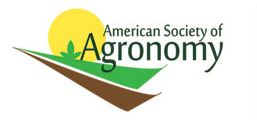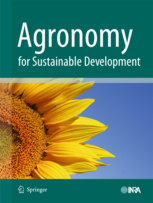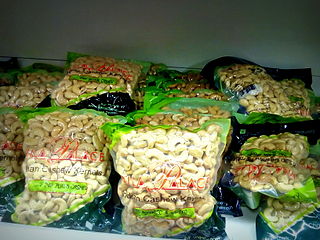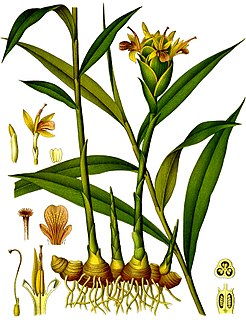
Agricultural science is a broad multidisciplinary field of biology that encompasses the parts of exact, natural, economic and social sciences that are used in the practice and understanding of agriculture.

Agriculture is the science and art of cultivating plants and livestock. Agriculture was the key development in the rise of sedentary human civilization, whereby farming of domesticated species created food surpluses that enabled people to live in cities. The history of agriculture began thousands of years ago. After gathering wild grains beginning at least 105,000 years ago, nascent farmers began to plant them around 11,500 years ago. Pigs, sheep and cattle were domesticated over 10,000 years ago. Plants were independently cultivated in at least 11 regions of the world. Industrial agriculture based on large-scale monoculture in the twentieth century came to dominate agricultural output, though about 2 billion people still depended on subsistence agriculture into the twenty-first.

Quinoa is a flowering plant in the amaranth family. It is a herbaceous annual plant grown as a grain crop primarily for its edible seeds. Quinoa is not a grass like wheat or rice, but rather a pseudocereal botanically related to spinach and amaranth. After harvest, the seeds are processed to remove the bitter-tasting outer seed coat.

A farmer is a person engaged in agriculture, raising living organisms for food or raw materials. The term usually applies to people who do some combination of raising field crops, orchards, vineyards, poultry, or other livestock. A farmer might own the farmed land or might work as a laborer on land owned by others, but in advanced economies, a farmer is usually a farm owner, while employees of the farm are known as farm workers, or farmhands. However, in the not so distant past, a farmer was a person who promotes or improves the growth of by labor and attention, land or crops or raises animals.

Agronomy is the science and technology of producing and using plants for food, fuel, fiber, and land reclamation. Agronomy has come to encompass work in the areas of plant genetics, plant physiology, meteorology, and soil science. It is the application of a combination of sciences like biology, chemistry, economics, ecology, earth science, and genetics. Agronomists of today are involved with many issues, including producing food, creating healthier food, managing the environmental impact of agriculture, and extracting energy from plants. Agronomists often specialise in areas such as crop rotation, irrigation and drainage, plant breeding, plant physiology, soil classification, soil fertility, weed control, and insect and pest control.

Intercropping is a multiple cropping practice involving growing two or more crops in proximity. The most common goal of intercropping is to produce a greater yield on a given piece of land by making use of resources or ecological processes that would otherwise not be utilized by a single crop.
Agrology is the branch of soil science dealing with the production of crops. The use of the term is most active in Canada. Use of the term outside Canada is sporadic but significant. The term appears especially well established in Russia and China, with agrologists on university faculty lists and agrology curricula.

Agroforestry is a land use management system in which trees or shrubs are grown around or among crops or pastureland. This intentional combination of agriculture and forestry has varied benefits, including increased biodiversity and reduced erosion. Agroforestry practices have been successful in sub-Saharan Africa and in parts of the United States.

Agriculture in Greece is based on small-sized, family-owned dispersed units, while the extent of cooperative organization stays at low comparative levels, against all efforts that have been taken in the last 30 years, mainly under European Union supervision. Greek agriculture employs 528,000 farmers, 12% of the total labor force. It only produces 3.6% of the national GDP. A large number of the country's immigrants are employed in the agricultural sector of the economy, as well as construction and public works.

The American Society of Agronomy (ASA) is a scientific and professional society of agronomists and scientists of related disciplines, principally in the United States but with a large number of non-U.S. members as well.

Professional agrologist in Canada, also called Certified professional agronomist in the United States or agronome in Québec is a certification for the agrology profession in North America. There are approximately 10,000 professional agrologists and agronomes in Canada registered in 10 provincial institutes of agrology as well as 13,000 Certified professional agronomists in the United States. Agrologists act as consultants to the agricultural sector, using fields such as animal science, food science, genetic engineering, soil science and environmental sciences. Professional agrologists are found providing advice directly to farmers, in communications and financial roles, in the fertilizer and seed business, food processing plants, in turf management and golf course operations as well as in agricultural organizations and corporations.

Agricultural engineering is the engineering discipline that studies agricultural production and processing. Agricultural engineering combines the disciplines of mechanical, civil, electrical and chemical engineering principles with a knowledge of agricultural principles according to technological principles. A key goal of this discipline is to improve the efficacy and sustainability of agricultural practices. One of the leading organizations in this industry is the American Society of Agricultural and Biological Engineers.

Agronomy for Sustainable Development is a bimonthly peer-reviewed scientific journal covering research on the interactions between cropping systems and other activities in the context of sustainable development. It is published by Springer Science+Business Media on behalf of the French Institut National de la Recherche Agronomique. Articles are freely accessible one year after their publication. According to the Journal Citation Reports, the journal has a 2016 impact factor of 4.101.
Agriculture in the Bahamas is the third largest pillar of the Bahamian economy, representing between 5% and 7% of its total GDP.

Glenn W. Burton was an American agricultural scientist notable for his pioneering work in plant breeding, development of pearl millet in 1956 and for other contributions that helped increase world food production.

The University of Kragujevac Faculty of Agronomy at Čačak, located in Čačak, Serbia, is one of the educational institutions of the University of Kragujevac.
The industry of agriculture in Puerto Rico constitutes about US$808 million or about 0.8% of the island's gross domestic product (GDP). The infrastructure of "traditional" crops is affected, but that is where the widespread use of hydroponic crops is relevant; the main concern with them is actually cost, since indoor structures should be safe from nature. Experts from the University of Puerto Rico argued that these crops could cover approx. 30% of the local demand, particularly that of smaller vegetables such as tomatoes, lettuce, etc. and several kinds of tubers that are currently being imported, opening the door to eventual exportation. The existence of a thriving agricultural economy has been prevented due to a shift in priorities towards industrialization, bureaucratization, mismanagement of terrains, lack of alternative methods and a deficient workforce. Its geographical location within the Caribbean exacerbates these issues, making the scarce existing crops propense to the devastating effects of Atlantic hurricanes.

The Cashew business in Kollam is based in the eponymous city, which is known as the Cashew Capital of the World. Kollam is the largest processed cashew exporter in the world. As of 2011 there were more than 600 cashew processing units in the city. About 800,000 tonnes of raw cashews are imported to the city for processing every year. 80% of India's export quality cashew kernels are prepared in Kollam. Kollam remained as the cashew capital of the world for decades since 1930s.
Tashkent State Agrarian University or TSAU is an agricultural university located in Tashkent, Uzbekistan.
Agronomy Journal is a peer-reviewed scientific journal published by American Society of Agronomy. The journal publishes articles related to soil science, crop science, agroclimatology and agronomic modeling, production agriculture, and software.













